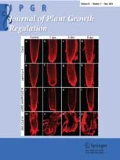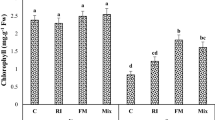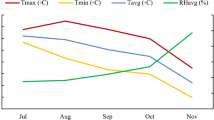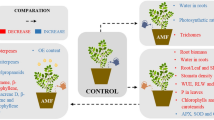Abstract
In recent years, the application of arbuscular mycorrhizal fungi (AMF) has been considered to be an important strategy for improving crop yield and quality. In the present study, a factorial experiment based on a complete randomized design with two factors was performed to investigate the effect of AMF and water stress on the essential oil (EO) composition, antioxidant activity, and physiological and morphological characteristics of rose-scented geranium (Pelargonium graveolens L.). The factors included AMF inoculation (Rhizophagus intraradices, Funneliformis mosseae, and a mixture of both species) and irrigation levels [well-watered (WW), moderate drought stress (MDS), and severe drought stress (SDS)]. The main EO constituents were citronellol (31–37%) and geraniol (9–14%) in all treatments. Under water-stress conditions, some constituents increased, such as geraniol and geranyl formate, whereas others decreased, such as linalool, menthone and rose oxide. Overall, the highest amount of citronellol (37.3%) and geraniol (14.8%) was obtained in the plants inoculated with F. mosseae and R. intraradices under WW and MDS conditions, respectively. Antioxidant activity, total flavonoids, and phenolics were increased because of AMF inoculation, whereas a different trend was observed for the phenolic and flavonoid contents under water-stress conditions. Furthermore, water deficit elevated the amount of soluble carbohydrates as well as the proline content, whereas the amount of proline was lower in inoculated plants than in non-inoculated ones. All the growth parameters were improved in the AMF-inoculated plants compared to non-inoculated ones under different irrigation regimes. Drought conditions decreased the photosynthetic pigments and efficiency, whereas AMF plants ameliorated the adverse effect of drought conditions. In general, mycorrhizal inoculation resulted in an improvement in the growth parameters as well as the phytochemical and physiological characteristics of rose-scented geranium.



Similar content being viewed by others
References
Adams RP (2001) Quadrupole mass spectra of compounds listed in order of their retention time on db-5. Identification of essential oils components by gas chromatography/quadrupole mass spectroscopy. Allured Publishing Corporation, Carol Stream
Alinian S, Razmjoo J (2014) Phenological, yield, essential oil yield and oil content of cumin accessions as affected by irrigation regimes. Ind Crops Prod 54:167–174. doi:10.1016/j.indcrop.2014.01.028
Arbona V, Manzi M, Ollas C de, Gómez-Cadenas A (2013) Metabolomics as a tool to investigate abiotic stress tolerance in plants. Int J Mol Sci 14:4885–4911. doi:10.3390/ijms14034885
Aroca R, del Mar Alguacil M, Vernieri P, Ruiz-Lozano JM (2008) Plant responses to drought stress and exogenous ABA application are modulated differently by mycorrhization in tomato and an ABA-deficient mutant (sitiens). Microb Ecol 56:704–719. doi:10.1007/s00248-008-9390-y
Asrar AA, Abdel-Fattah GM, Elhindi KM (2012) Improving growth, flower yield, and water relations of snapdragon (Antirhinum majus L.) plants grown under well-watered and water-stress conditions using arbuscular mycorrhizal fungi. Photosynthetica 50:305–316. doi:10.1007/s11099-012-0024-8
Augé RM (2004) Arbuscular mycorrhizae and soil/plant water relations. Can J Soil Sci 84:373–381. doi:10.4141/s04-002
Augé RM, Toler HD, Saxton AM (2015) Arbuscular mycorrhizal symbiosis alters stomatal conductance of host plants more under drought than under amply watered conditions: a meta-analysis. Mycorrhiza 25:13–24. doi:10.1007/s00572-014-0585-4
Baslam M, Esteban R, García-Plazaola JI, Goicoechea N (2013) Effectiveness of arbuscular mycorrhizal fungi (AMF) for inducing the accumulation of major carotenoids, chlorophylls and tocopherol in green and red leaf lettuces. Appl Microbiol Biotechnol 97:3119–3128. doi:10.1007/s00253-012-4526-x
Bates LS, Waldren RP, Teare ID (1973) Rapid determination of free proline for water-stress studies. Plant Soil 39:205–207. doi:10.1007/bf00018060
Boukhris M, Nasri-Ayachi MB, Mezghani I et al (2013) Trichomes morphology, structure and essential oils of Pelargonium graveolens L’Hér. (Geraniaceae). Ind Crops Prod 50:604–610. doi:10.1016/j.indcrop.2013.08.029
Ceccarelli N, Curadi M, Martelloni L et al (2010) Mycorrhizal colonization impacts on phenolic content and antioxidant properties of artichoke leaves and flower heads two years after field transplant. Plant Soil 335:311–323. doi:10.1007/s11104-010-0417-z
Dadrasan M, Chaichi MR, Pourbabaee AA et al (2015) Deficit irrigation and biological fertilizer influence on yield and trigonelline production of fenugreek. Ind Crops Prod 77:156–162. doi:10.1016/j.indcrop.2015.08.040
De Abreu IN, Mazzafera P (2005) Effect of water and temperature stress on the content of active constituents of Hypericum brasiliense Choisy. Plant Physiol Biochem 43:241–248. doi:10.1016/j.plaphy.2005.01.020
Diaz-Lopez L, Gimeno V, Simón I et al (2012) Jatropha curcas seedlings show a water conservation strategy under drought conditions based on decreasing leaf growth and stomatal conductance. Agric water Manag 105:48–56. doi:10.1016/j.agwat.2012.01.001
Dubois M, Gilles KA, Hamilton JK et al (1956) Colorimetric method for determination of sugars and related substances. Anal Chem 28:350–356. doi:10.1021/ac60111a017
Dutta SC, Neog B (2016) Accumulation of secondary metabolites in response to antioxidant activity of turmeric rhizomes co-inoculated with native arbuscular mycorrhizal fungi and plant growth promoting rhizobacteria. Sci Hortic 204:179–184. doi:10.1016/j.scienta.2016.03.028
Entry JA, Rygiewicz PT, Watrud LS, Donnelly PK (2002) Influence of adverse soil conditions on the formation and function of arbuscular mycorrhizas. Adv Environ Res 7:123–138. doi:10.1016/s1093-0191(01)00109-5
Geneva MP, Stancheva IV, Boychinova MM et al (2010) Effects of foliar fertilization and arbuscular mycorrhizal colonization on Salvia officinalis L. growth, antioxidant capacity, and essential oil composition. J Sci Food Agric 90:696–702. doi:10.1002/jsfa.3871
Giovannetti M, Mosse B (1980) An evaluation of techniques for measuring vesicular arbuscular mycorrhizal infection in roots. New Phytol 84:489–500. doi:10.1111/j.1469-8137.1980.tb04556.x
Giovannetti M, Avio L, Sbrana C (2010) Fungal spore germination and pre-symbiotic mycelial growth–physiological and genetic aspects. In: Koltai H, Kapulnik Y (eds) Arbuscular mycorrhizas: physiology and function. Springer, New York, pp 3–32. doi:10.1007/978-90-481-9489-6_1
Grümberg BC, Urcelay C, Shroeder MA et al (2015) The role of inoculum identity in drought stress mitigation by arbuscular mycorrhizal fungi in soybean. Biol Fertil Soils 51:1–10. doi:10.1007/s00374-014-0942-7
Hameed A, Wu QS, Abd-Allah EF et al (2014) Role of AM fungi in alleviating drought stress in plants. In: Miransari M (ed) Use of microbes for the alleviation of soil stresses. Springer, New York, pp 55–75. doi:10.1007/978-1-4939-0721-2_4
Harrewijn P, van Oosten AM, Piron PG (2012) Natural terpenoids as messengers: a multidisciplinary study of their production, biological functions and practical applications. Springer, Netherlands. doi:10.1007/978-94-010-0767-2
Jahansouz MR, Afshar RK, Heidari H, Hashemi M (2014) Evaluation of yield and quality of sorghum and millet as alternative forage crops to corn under normal and deficit irrigation regimes. Jordan J Agric Sci 10:699–714
Kapoor R, Chaudhary V, Bhatnagar AK (2007) Effects of arbuscular mycorrhiza and phosphorus application on artemisinin concentration in Artemisia annua L. Mycorrhiza 17:581–587. doi:10.1007/s00572-007-0135-4
Kara Z, Arslan D, Güler M, Güler Ş (2015) Inoculation of arbuscular mycorrhizal fungi and application of micronized calcite to olive plant: effects on some biochemical constituents of olive fruit and oil. Sci Hortic 185:219–227. doi:10.1016/j.scienta.2015.02.001
Karagiannidis N, Thomidis T, Lazari D et al (2011) Effect of three Greek arbuscular mycorrhizal fungi in improving the growth, nutrient concentration, and production of essential oils of oregano and mint plants. Sci Hortic 129:329–334. doi:10.1016/j.scienta.2011.03.043
Khaosaad T, Vierheilig H, Nell M et al (2006) Arbuscular mycorrhiza alter the concentration of essential oils in oregano (Origanum sp., Lamiaceae). Mycorrhiza 16:443–446. doi:10.1007/s00572-006-0062-9
Ko KN, Lee KW, Lee SE, Kim ES (2007) Development and ultrastructure of glandular trichomes in pelargonium × fragrans “mabel grey” (geraniaceae). J Plant Biol 50:362–368. doi:10.1007/bf03030668
Koleva II, van Beek TA, Linssen JPH et al (2002) Screening of plant extracts for antioxidant activity: a comparative study on three testing methods. Phytochem Anal 13:8–17. doi:10.1002/pca.611
Lebart L, Morineau A, Warwick KM (1984) Multivariate descriptive statistical analysis: correspondence analysis and related techniques for large matrices. Wiley, New York
Lee B, Jin Y, Jung W et al (2008) Water-deficit accumulates sugars by starch degradation—not by de novo synthesis—in white clover leaves (Trifolium repens). Physiol Plant 134:403–411. doi:10.1111/j.1399-3054.2008.01156.x
Lermen C, Morelli F, Gazim ZC et al (2015) Essential oil content and chemical composition of Cymbopogon citratus inoculated with arbuscular mycorrhizal fungi under different levels of lead. Ind Crops Prod 76:734–738. doi:10.1016/j.indcrop.2015.07.009
Lichtenthaler HK (1987) Chlorophylls and carotenoids: pigments of photosynthetic biomembranes. Methods Enzymol 148:350–382. doi:10.1016/0076-6879(87)48036-1
Lis-Balchin M (2006) Aromatherapy science: a guide for healthcare professionals. Pharmaceutical press, London
Lutts S, Majerus V, Kinet J (1999) NaCl effects on proline metabolism in rice (Oryza sativa) seedlings. Physiol Plant 105:450–458. doi:10.1034/j.1399-3054.1999.105309.x
Malatova K, Hitimana N, Niyibizi T et al (2011) Optimization of harvest regime and post-harvest handling in geranium production to maximize essential oil yield in Rwanda. Ind Crops Prod 34:1348–1352. doi:10.1016/j.indcrop.2010.12.018
Mandal S, Upadhyay S, Wajid S et al (2015) Arbuscular mycorrhiza increase artemisinin accumulation in Artemisia annua by higher expression of key biosynthesis genes via enhanced jasmonic acid levels. Mycorrhiza 25:345–357. doi:10.1007/s00572-014-0614-3
Manoharan PT, Shanmugaiah V, Balasubramanian N et al (2010) Influence of AM fungi on the growth and physiological status of Erythrina variegata Linn. grown under different water stress conditions. Eur J Soil Biol 46:151–156. doi:10.1016/j.ejsobi.2010.01.001
Maya MA, Matsubara Y (2013) Influence of arbuscular mycorrhiza on the growth and antioxidative activity in cyclamen under heat stress. Mycorrhiza 23:381–390. doi:10.1007/s00572-013-0477-z
McDonald S, Prenzler PD, Antolovich M, Robards K (2001) Phenolic content and antioxidant activity of olive extracts. Food Chem 73:73–84. doi:10.1016/s0308-8146(00)00288-0
Nasim G (2010) The role of Arbuscular mycorrhizae in inducing resistance to drought and salinity stress in crops. In: Ashraf M, Ozturk M, Ahmad MSA (eds) Plant adaptation and phytoremediation. Springer, New York, pp 119–141. doi:10.1007/978-90-481-9370-7_6
Pandey V, Patra DD (2015) Crop productivity, aroma profile and antioxidant activity in Pelargonium graveolens L’Hér. under integrated supply of various organic and chemical fertilizers. Ind Crops Prod 67:257–263. doi:10.1016/j.indcrop.2015.01.042
Phillips JM, Hayman DS (1970) Improved procedures for clearing roots and staining parasitic and vesicular–arbuscular mycorrhizal fungi for rapid assessment of infection. Trans Br Mycol Soc 55:158–IN18. doi:10.1016/s0007-1536(70)80110-3
Porcel R, Ruiz-Lozano JM (2004) Arbuscular mycorrhizal influence on leaf water potential, solute accumulation, and oxidative stress in soybean plants subjected to drought stress. J Exp Bot 55:1743–1750. doi:10.1093/jxb/erh188
Rao BRR (2002) Biomass yield, essential oil yield and essential oil composition of rose-scented geranium (Pelargonium species) as influenced by row spacings and intercropping with cornmint (Mentha arvensis Lf piperascens Malinv. ex Holmes). Ind Crops Prod 16:133–144. doi:10.1016/s0926-6690(02)00038-9
Rapparini F, Llusià J, Peñuelas J (2008) Effect of arbuscular mycorrhizal (AM) colonization on terpene emission and content of Artemisia annua L. Plant Biol 10:108–122. doi:10.1055/s-2007-964963
Rebey IB, Jabri-Karoui I, Hamrouni-Sellami I et al (2012) Effect of drought on the biochemical composition and antioxidant activities of cumin (Cuminum cyminum L.) seeds. Ind Crops Prod 36:238–245. doi:10.1016/j.indcrop.2011.09.013
Rydlová J, Jelínková M, Dušek K et al (2015) Arbuscular mycorrhiza differentially affects synthesis of essential oils in coriander and dill. Mycorrhiza 26:123–131. doi:10.1007/s00572-015-0652-5
Sairam RK, Deshmukh PS, Shukla DS (1997) Tolerance of drought and temperature stress in relation to increased antioxidant enzyme activity in wheat. J Agron Crop Sci 178:171–178. doi:10.1111/j.1439-037x.1997.tb00486.x
Schellenbaum L, Müller J, Boller T et al (1998) Effects of drought on non-mycorrhizal and mycorrhizal maize: changes in the pools of non-structural carbohydrates, in the activities of invertase and trehalase, and in the pools of amino acids and imino acids. New Phytol 138:59–66. doi:10.1046/j.1469-8137.1998.00892.x
Scholander PF, Hammel HT, Bradstreet ED, Hemmingsen EA (1965) Sap pressure in vascular plants. Science 148:339–346. doi:10.1126/science.148.3668.339
Selvaraj T, Nisha MC, Rajeshkumar S (2009) Effect of indigenous arbuscular mycorrhizal fungi on some growth parameters and phytochemical constituents of Pogostemon patchouli Pellet. Maejo Int J Sci Technol 3:222–234. http://www.mijst.mju.ac.th/vol3/222-234.pdf
Sheng M, Tang M, Chen H et al (2008) Influence of arbuscular mycorrhizae on photosynthesis and water status of maize plants under salt stress. Mycorrhiza 18:287–296. doi:10.1007/s00572-008-0180-7
Smith SE, Read DJ (2008) Mycorrhizal symbiosis. 3rd edn. Elsevier, Amsterdam. http://www.sciencedirect.com/science/book/9780123705266
Sun XP, Yan HL, Kang XY, Ma FW (2013) Growth, gas exchange, and water-use efficiency response of two young apple cultivars to drought stress in two scion-one rootstock grafting system. Photosynthetica 51:404–410. doi:10.1007/s11099-013-0040-3
Urcoviche RC, Gazim ZC, Dragunski DC et al (2015) Plant growth and essential oil content of Mentha crispa inoculated with arbuscular mycorrhizal fungi under different levels of phosphorus. Ind Crops Prod 67:103–107. doi:10.1016/j.indcrop.2015.01.016
Valentovic P, Luxova M, Kolarovic L, Gasparikova O (2006) Effect of osmotic stress on compatible solutes content, membrane stability and water relations in two maize cultivars. Plant Soil Environ 52:186–191. http://81.0.228.28/publicFiles/50539.pdf
Venkateshwaran M, Jayaraman D, Chabaud M et al (2015) A role for the mevalonate pathway in early plant symbiotic signaling. Proc Natl Acad Sci 112:9781–9786. doi:10.1073/pnas.1413762112
Wu QS, Xia RX (2006) Arbuscular mycorrhizal fungi influence growth, osmotic adjustment and photosynthesis of citrus under well-watered and water stress conditions. J Plant Physiol 163:417–425. doi:10.1016/j.jplph.2005.04.024
Wu QS, Srivastava AK, Zou YN (2013) AMF-induced tolerance to drought stress in citrus: a review. Sci Hortic (Amsterdam) 164:77–87. doi:10.1016/j.scienta.2013.09.010
Zhao R, Guo W, Bi N et al (2015) Arbuscular mycorrhizal fungi affect the growth, nutrient uptake and water status of maize (Zea mays L.) grown in two types of coal mine spoils under drought stress. Appl Soil Ecol 88:41–49. doi:10.1016/j.apsoil.2014.11.016
Zhishen J, Mengcheng T, Jianming W (1999) The determination of flavonoid contents in mulberry and their scavenging effects on superoxide radicals. Food Chem 64:555–559. doi:10.1016/s0308-8146(98)00102-2
Zou YN, Wu QS, Huang YM et al (2013) Mycorrhizal-mediated lower proline accumulation in Poncirus trifoliata under water deficit derives from the integration of inhibition of proline synthesis with increase of proline degradation. PLoS One 8:e80568. doi:10.1371/journal.pone.0080568
Zubek S, Rola K, Szewczyk A et al (2015) Enhanced concentrations of elements and secondary metabolites in Viola tricolor L. induced by arbuscular mycorrhizal fungi. Plant Soil 390:129–142. doi:10.1007/s11104-015-2388-6
Acknowledgements
The authors appreciate the contributions of the Isfahan University of Technology and Barij Essence Company, Kashan for their scientific and financial support.
Author information
Authors and Affiliations
Corresponding authors
Rights and permissions
About this article
Cite this article
Amiri, R., Nikbakht, A., Rahimmalek, M. et al. Variation in the Essential Oil Composition, Antioxidant Capacity, and Physiological Characteristics of Pelargonium graveolens L. Inoculated with Two Species of Mycorrhizal Fungi Under Water Deficit Conditions. J Plant Growth Regul 36, 502–515 (2017). https://doi.org/10.1007/s00344-016-9659-1
Received:
Accepted:
Published:
Issue Date:
DOI: https://doi.org/10.1007/s00344-016-9659-1




